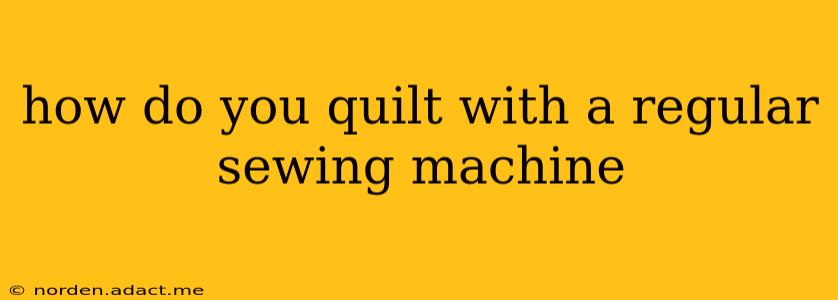Quilting, the art of stitching layers of fabric together, doesn't require a fancy longarm machine. You can create beautiful quilts using your regular sewing machine! This guide will walk you through the process, addressing common questions and providing tips for success.
What You'll Need to Quilt with a Sewing Machine
Before you begin, gather these essential supplies:
- Sewing Machine: Your trusty machine will be your primary tool. Make sure it's well-maintained and oiled.
- Quilting Fabric: Choose fabrics appropriate for your project. Consider pre-washing to prevent shrinkage.
- Batting: This is the fluffy middle layer of your quilt, providing warmth and texture. Popular choices include cotton, polyester, and wool.
- Backing Fabric: This will be the back of your quilt. Select a sturdy fabric that won't easily fray.
- Quilting Needles: Use a needle appropriate for your fabric and thread. A universal needle is a good starting point. Consider using a microtex needle for finer fabrics.
- Quilting Thread: Choose a strong thread that will withstand the stress of quilting. Cotton or polyester thread is common.
- Rotary Cutter, Ruler, & Cutting Mat: These tools make accurate cutting quick and easy.
- Iron & Ironing Board: Pressing is crucial for neat seams and a finished look.
- Pins or Clips: To hold your layers together. Clips are often preferred for quilting as they don't leave holes.
- Walking Foot (Optional but Highly Recommended): A walking foot helps feed all three layers of your quilt evenly, preventing fabric puckering and achieving consistent stitching.
Preparing Your Quilt Layers for Sewing Machine Quilting
How to Layer Your Quilt for Machine Quilting?
Layering your quilt correctly is the foundation of a successful project. Start by placing your backing fabric right side down on a large, flat surface. Then, lay your batting on top, followed by your quilt top (right side up). Smooth out any wrinkles and ensure the layers are perfectly aligned. Use pins or clips to secure the layers together, especially around the edges.
How Do I Keep My Quilt Layers From Shifting While Quilting?
Shifting layers are a common quilting frustration. Basting is a crucial step to prevent this. Basting involves temporarily stitching the three layers together. You can use safety pins, basting spray (temporarily bonds layers), or hand-basting stitches. For larger quilts, a combination of techniques is often recommended. Focus on basting more densely in areas with intricate designs.
Choosing Your Quilting Pattern
What are the Easiest Quilting Patterns for Beginners?
Beginners often start with straight-line quilting. This involves stitching parallel lines across the quilt. Other simple patterns include:
- Meandering: Free-motion stitching in a wavy pattern. Requires a darning foot (for free motion)
- Diagonal lines: Similar to straight-line quilting but at an angle.
- Grid pattern: Creating a grid of squares or rectangles using straight lines.
What is Free Motion Quilting on a Regular Sewing Machine?
Free-motion quilting lets you stitch any pattern you want without following marked lines. It requires a darning foot, which allows the feed dogs to be lowered, giving you more control over the fabric movement. This requires practice but allows for creative freedom.
Quilting on Your Sewing Machine: Step-by-Step
- Select your stitch: Choose a stitch appropriate for your quilting pattern. A straight stitch is commonly used.
- Adjust your tension: Ensure your machine's tension is properly adjusted for your fabric and thread.
- Start quilting: Begin quilting in sections, moving your quilt under the needle. Use your walking foot for even feeding.
- Maintain consistent speed: Avoid going too fast to prevent skipped stitches.
- Pivot at corners: Practice pivoting techniques for neat corners and curves.
- Keep your fingers away from the needle.
How Do I Bind the Edges of My Quilt?
Binding is the final step, adding a professional finish. This involves creating a fabric strip that's sewn around the quilt's edges, hiding raw edges. There are several binding techniques, from simple to more complex. Many tutorials are available online to guide you through the process.
Troubleshooting Common Problems
- Puckering: Caused by uneven feeding. Use a walking foot and ensure even tension.
- Skipped stitches: Check your needle, thread, and machine tension.
- Broken needles: Use the correct needle for your fabric.
- Uneven stitching: Maintain consistent speed and tension.
Quilting with a regular sewing machine is achievable with practice and patience. Start with simple patterns and gradually increase complexity as you gain confidence. Remember to enjoy the process and the satisfaction of creating your own beautiful quilt!
